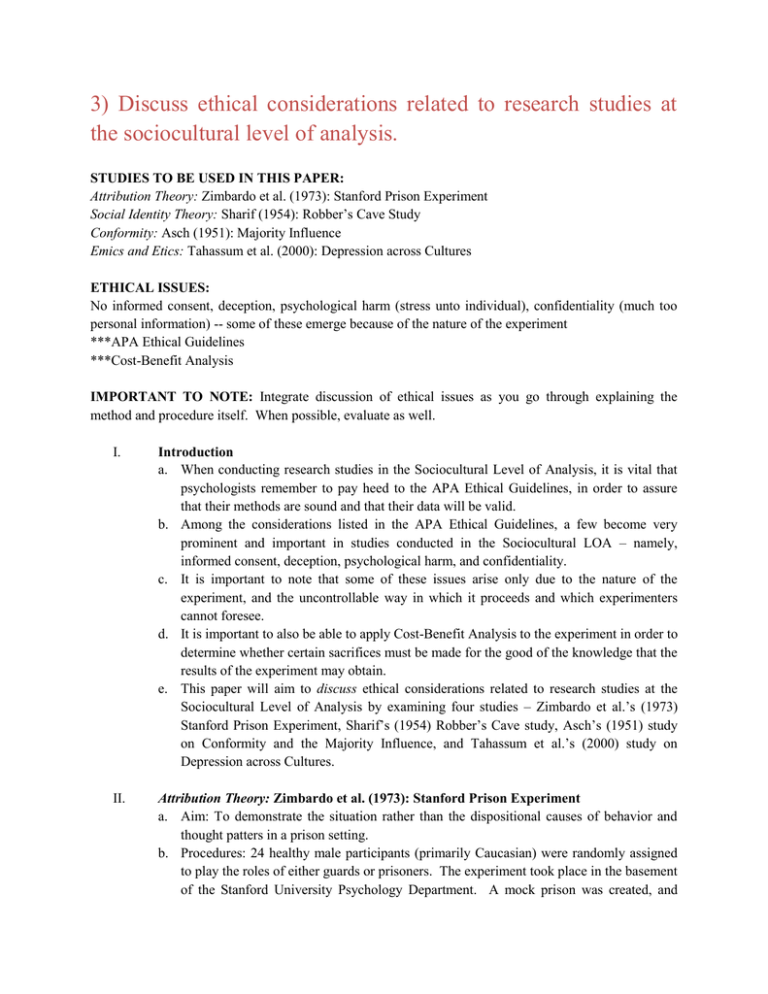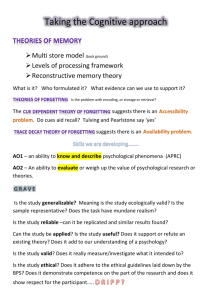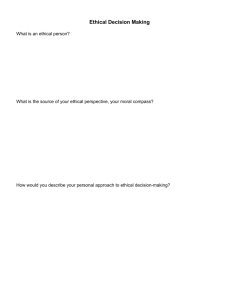3) Discuss ethical considerations related to research studies at the
advertisement

3) Discuss ethical considerations related to research studies at the sociocultural level of analysis. STUDIES TO BE USED IN THIS PAPER: Attribution Theory: Zimbardo et al. (1973): Stanford Prison Experiment Social Identity Theory: Sharif (1954): Robber’s Cave Study Conformity: Asch (1951): Majority Influence Emics and Etics: Tahassum et al. (2000): Depression across Cultures ETHICAL ISSUES: No informed consent, deception, psychological harm (stress unto individual), confidentiality (much too personal information) -- some of these emerge because of the nature of the experiment ***APA Ethical Guidelines ***Cost-Benefit Analysis IMPORTANT TO NOTE: Integrate discussion of ethical issues as you go through explaining the method and procedure itself. When possible, evaluate as well. I. Introduction a. When conducting research studies in the Sociocultural Level of Analysis, it is vital that psychologists remember to pay heed to the APA Ethical Guidelines, in order to assure that their methods are sound and that their data will be valid. b. Among the considerations listed in the APA Ethical Guidelines, a few become very prominent and important in studies conducted in the Sociocultural LOA – namely, informed consent, deception, psychological harm, and confidentiality. c. It is important to note that some of these issues arise only due to the nature of the experiment, and the uncontrollable way in which it proceeds and which experimenters cannot foresee. d. It is important to also be able to apply Cost-Benefit Analysis to the experiment in order to determine whether certain sacrifices must be made for the good of the knowledge that the results of the experiment may obtain. e. This paper will aim to discuss ethical considerations related to research studies at the Sociocultural Level of Analysis by examining four studies – Zimbardo et al.’s (1973) Stanford Prison Experiment, Sharif’s (1954) Robber’s Cave study, Asch’s (1951) study on Conformity and the Majority Influence, and Tahassum et al.’s (2000) study on Depression across Cultures. II. Attribution Theory: Zimbardo et al. (1973): Stanford Prison Experiment a. Aim: To demonstrate the situation rather than the dispositional causes of behavior and thought patters in a prison setting. b. Procedures: 24 healthy male participants (primarily Caucasian) were randomly assigned to play the roles of either guards or prisoners. The experiment took place in the basement of the Stanford University Psychology Department. A mock prison was created, and guards and prisoners had to wear costumes related to their roles. The experiment started with a surprise public arrest (deception). Overt observation was used as a general method. The experiment was supposed to run for 2 weeks, but it only ran for 6 days. c. Findings: Prisoners experienced a loss of personal identity and were deprived of adequate sleep and privacy. Half of the prisoners had to leave early because they developed emotional and cognitive disorders. Data consisted mostly of videotapes, audiotapes, questionnaires, personality self-reports, interviews, etc. d. Conclusion: Situational factors are significant in determining a person’s behavior. e. ETHICAL ISSUES i. PSYCHOLOGICAL HARM (Relate to the nature of the experiment itself, especially for the prisoners. Relate also to the role of the guards and their mental states being affected by this experiment) ii. PHYSICAL HARM (Some of the prisoners were subject to light forms of “torture” from the guards and were made to do strenuous tasks) iii. DECEPTION (The participants were not fully briefed on the nature of the experiment, and it started with a surprise arrest) III. Social Identity Theory: Sharif (1954): Robber’s Cave Study a. Aim: To determine the extent to which social identity theory affects the perceptions of one group towards another group. b. Procedures: This was a matched pairs’ experiment that involved covert observation. The setting was a summer camp. 22 twelve year old boys were divided into two groups (the rattlers and the eagles) and were made to stay on opposite ends of the camp for a number of days. Afterwards, they were brought together and made to participate in competitions.The experimenters observed hostility within the early days of contact. In fact, it got so competitive that they could not continue activities safely. The groups were then made to go integration activities and such common goals established cooperation. Thus, the boys went through 3 phases: in-group formation, friction phase, and the integration phase. c. Findings and Conclusions: Boys were hostile at first, but then learned to work together once there were integration activities. Therefore, though hostility between two opposing groups can easily form, finding common ground can also lead to conflict resolution. d. ETHICAL ISSUES i. PSYCHOLOGICAL HARM (Competition was forced or imposed, which may have caused stress or trouble for some individuals) ii. INFORMED CONSENT (The participants did not know they were being observed) IV. Conformity: Asch (1951): Majority Influence a. Aim: To discover the extent to which a person would conform to a correct answer on a test if the response from the other members of the group was unanimous. b. Procedures: The participant was asked to enter a room with six people and the researcher. The other people in the room were dressed in suits and ties and were pretending to be participants when, in fact, they were part of the study. These people are called confederates, and they helped deceive the participant. Participants were shown cards with lines and were asked to select the line from another card that matched the length of the first line of the card. There were 18 trials in total, and confederates answered correctly for some and incorrectly for others. c. Findings and Conclusions: About 75% of the participants agreed with the confederates’ incorrect responses at least once.32% of the participants agreed with incorrect responses in half or more of the trials. However, 24% did NOT conform to any of the incorrect responses given by the confederates. This, nevertheless, still showed how the needto be part of the group is stronger than the desire to give the correct answer (majority influence). d. ETHICAL ISSUES i. DECEPTION (The use of confederates and the deliberate misleading of the nature of the experiment were not truthful in their aims and their methods) ii. PSYCHOLOGICAL STRESS (Being the only person at odds when it comes to making a decision or giving an aswer may have caused undue mental stress to the participants) V. Emics and Etics: Tahassum et al. (2000): Depression across Cultures a. Aim: To discover the differences between the emics and etics of depression which are used to evaluate it and treat it among ethnic populations living in a Western culture (Pakistanis in the U.K.) b. Procedures: Interviews were used and compared to determine the emic definitions of symptoms of depression among Pakistanis living in the United Kingdom, and were crossreferenced with the existing etic descriptions used by Western psychiatrists. First and second generation Pakistani women were used as participants (22 males and 57 females took part since females could not meet with researchers alone), and all lived in a poor urban setting. Interviews were conducted in a mixture of languages, and since only some families allowed recording of interviews, researchers had to rely on taking detailed notes. The interviews had 21 questions regarding the perception on the causes of the disorder, seeking help, community status of those with the disease, etc. c. Findings and Conclusions: 63% viewed aggression as a main symptom of abnormality, while 63% also said that stress was a primary factor. 25% percent of the participants attributed mental disorders to supernatural causes and 35% believed in faith healers. Most males thought a doctor should be consulted for treatment. Fewer females identified a doctor as the first person to consult, but there may be cultural barriers to women getting help from doctors. This helped researchers identity barriers that women face in getting mental health services and identifying the differences between emic and etic approaches in understanding mental disorders. d. ETHICAL ISSUES i. INFORMED CONSENT (As most of the participants were not in sound mental state, it was impossible to get full informed consent, though their husbands did so for them) VI. ii. CONFIDENTIALITY (Most of the questions asked were very personal, and the pressure of having the researchers asking them directly might have been to much for the participants to deny) iii. PSYCHOLOGICAL STRESS (Bringing back these memories or allowing this information to resurface may have been too much for the participants to handle, especially in their fragile emotional state) Conclusion a. Though following the APA Ethical Guidelines is essential to pursuing proper and sound research, it is important to also be able to apply Cost-Benefit Analysis to the experiment in order to determine whether certain sacrifices must be made for the good of the knowledge that the results of the experiment may obtain. b. Strengths: Debriefing and Informed Consent c. Weaknesses: Psychological Harm or Stress and Deception d. At the end of the day, these four experiments mentioned were able to make amazing leaps and discoveries in the theories and areas that they investigated, and much of the ethical considerations can be nullified because of this.




